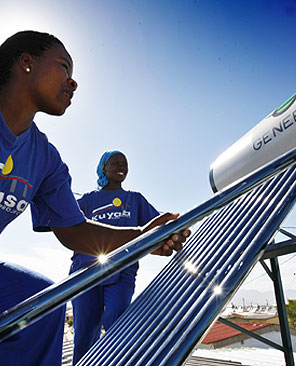South African Export Development Fund (“SAEDF”)
The SAEDF was formed in 2001 with a view to providing Venture Capital to start up early stage businesses engaged in the export of South African goods and services. The fund is a closed end fund in that any returns generated on the funds investments are re-invested in the fund. In this sense it is a non-profit fund.
In 2006 the SAEDF became involved in renewable energy projects both as advisor and finance provider because it believed that the industry was completely underdeveloped in South Africa and that huge potential existed for new and expanded local manufacturing to replace imported product.
The SAEDF believed that creation of demand for renewable energy products was the key to South Africa developing its manufacturing capability. Due to favourable climatic conditions the SAEDF decided to target Solar Water Heating in the first instance and identified the lack of available finance as the major obstacle to the mass uptake of Solar Water Heaters by South African Consumers.
In 2007, the SAEDF was instrumental in designing South Africa’s first pay for service financial model for financing the mass installation of SWH in the Nelson Mandela Bay Metro (“NMB”). The model showed that NMB could provide SWHs to its entire demographic of electricity users including low cost houses and generate a return commensurate with finance for other infrastructure projects. The NMB project was taken over by the Central Energy Fund.
The Kuyasa Pilot
In order to prove the viability of the pay for service model to the installation of SWHs in low income housing, the SAEDF undertook the implementation of the Kuyasa CDM project in Khayelitsha. The bulk of the funding for Kuyasa is provided by the Department of Environmental Affairs and Tourism, through the Expanded Public Works Programme. Additional funds were sourced from Provincial Housing and the balance of the funding is underwritten by the SAEDF.
Kuyasa is Africa’s first Clean Development Mechanism (CDM) – and the world’s first Gold Standard – project to be registered under the Kyoto Protocol on climate change. The Kuyasa pilot provides a model for sustainable energy service delivery (and financing) that can be applied to other housing projects. It simultaneously addresses environmental concerns, pro-poor service delivery, job creation, skills development and socio-economic upliftment.
This ground-breaking initiative earns carbon off-set credits through installing insulated ceilings, solar water heaters and energy efficient lighting in over 2300 existing RDP homes. The carbon income is earmarked for the maintenance and sustainable future expansion of the installations.
Carbon credits and CDM
Carbon credits are a key element in the SAEDF model for sustainable financing of SWHs on a large scale. This is generally true for all models, whether: funded privately or through municipal/government schemes; targeting low or high income housing; new or retro-fitting; commercial or residential. Registration of individual small-scale CDM projects is not viable in most instances and in any event involves extensive time and resources. There is a real and urgent need for a programmatic SWH registration, through which a myriad of small and/or large scale SWH installations could be part-financed.
As a first step, the SAEDF in co-operation with the NGO SouthSouthNorth, the Development Bank of South Africa and others has been financing the modeling and establishment of such a programmatic CDM.
The second step is to establish the operational co-ordinating entity through which CDM finance will be made practical for users. We see the programmatic CDM registration as a national asset to be managed in the public interest. Our vision is to make that asset operational - enabling government, private sector, large and small schemes alike to realise the income potential from Carbon Emission Reduction certificates (CERs).
It is critical that such an asset be managed in a transparent and accessible manner. It must deliver high quality, efficient services in a responsive and highly credible manner, which seeks to maximize the CER returns where they are most needed – in the hands of project implementers and target communities, where they can be used to finance ongoing maintenance and delivery. The facility should be able to assist clients in the design and monitoring of projects; it will need the capacity to actively seek out, support and promote worthwhile projects. The facility will need to produce the kind of outputs and develop the kind of reputation that provides financiers with risk-free data and reliable services that can be trusted.
The Kuyasa Case Study– progress towards a sustainable, financeable delivery model for low-income housing.
In order to finance the large scale roll-out of SWHs and other energy efficient applications in low income housing, the Kuyasa pilot has generated the data and practical experience to inform a realistic finance model. The SAEDF has also engaged other roll players whose participation is critical to the successful scaling up of the implementation nationally.



